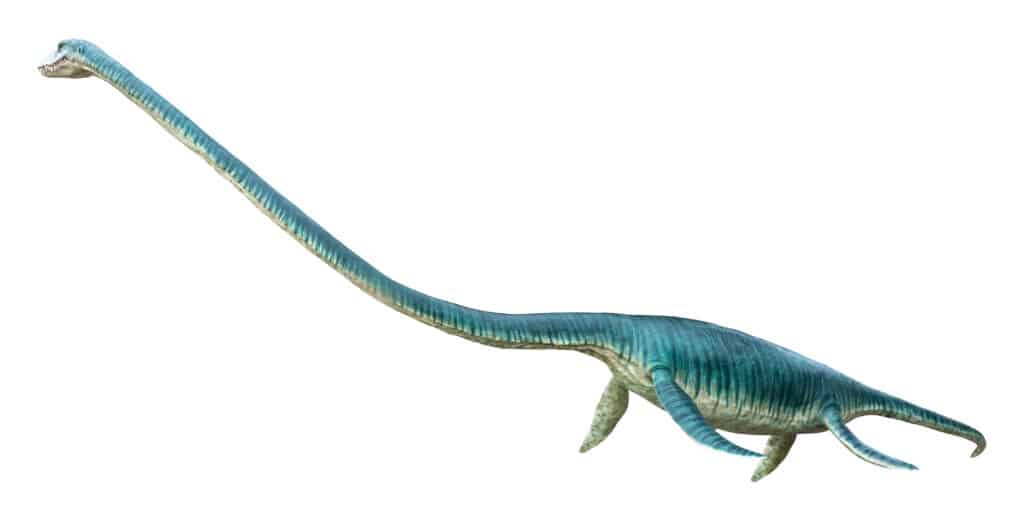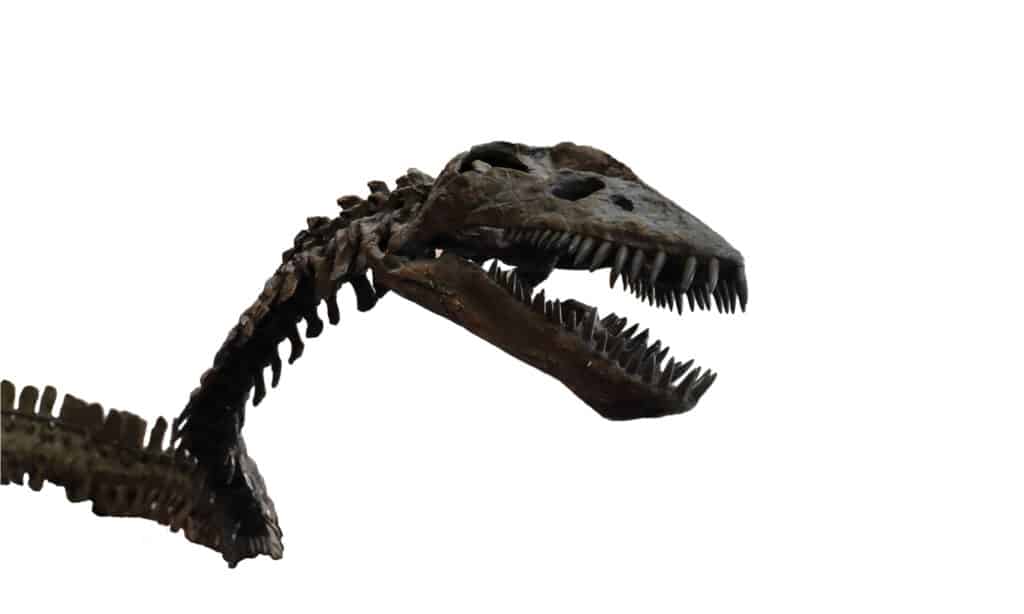What would fixing a giraffe’s neck on a sea turtle looks like? Scale up your imaginations, and you have the Elasmosaurus. The reptile with an astonishingly long neck lived in the ancient western sea.
The Elasmosaurus was not a dinosaur but a reptile. It belonged to the order Plesiosauria. This order was divided into the plesiosaurs and pliosaurs. They were all ancient reptiles. These reptiles lived during the Campanian stage of the Late Cretaceous period. This was about 83.6 to 72.1 million years ago.
The only known species of the Elasmosauridae family is Elasmosaurus platyurus. This name was given as a result of the initial misinterpretation of the animal’s fossil. In this article, we’ll take a journey to the Late Cretaceous Period to understand how this ancient sea reptile lived before its extinction.
Description and Size
The Elasmosaurus is a generic name that means “thin-plate reptile.” This was in reference to the plate-like bones found in the sternal and pelvis regions of the creature. Its specific name, platyurus, means “flat-tailed,” which refers to its compressed tail. It was discovered that the ‘flat tail’ was its neck.
The recovered fossils of Elasmosaurus are in fragments and still have many missing elements. However, to describe the Elasmosaurus, the creature would have had a compact and streamlined body to move seamlessly in the sea.
It had paddle-like limbs, similar to modern-day turtles but larger. The limbs were used for propelling the large animal through the ocean. It had a short tail, a long neck, and a small triangular head.
The Elasmosaurus had an estimated length of 13.1 meters (43ft). But Cope estimated the length of the animal by considering the missing parts. He also added the length of vertebral bodies and cartilages between each body. He concluded that the animal was roughly 13.7meters (45ft) long.
The Elasmosaurus had a proportionately small, slender, and triangular skull. This is common to all elasmosaurids. It was uncertain how many teeth the animal had, but paleontologists proposed it must have had six teeth in its premaxillae (this formed the front of its upper jaw). These teeth were large and fang-like. The total number of teeth was estimated to be 14 in its upper jaw and 17-19 in its lower jaw.
The Elasmosaurus was estimated to have weighed up to 2tonnes. Their large pad-like limbs and streamlined body contributed to their movement in their habitat.
Elasmosaurus’ Neck

©YuRi Photolife/Shutterstock.com
The Elasmosaurus’ most unique feature was its extremely long neck. Unlike its counterparts—the pliosaurs, who had short necks. Elasmosaurus’ neck makes up approximately half the length of the animal. Its neck was estimated to be about 7.1meters (23ft) in length. The Elasmosaurus was one of the animals with the longest necks to have ever lived. However, its long neck was less than half the length of the longest-necked sauropod dinosaurs.
The Elasmosaurus neck had the highest number of cervical vertebrae ever known of any vertebrate animal. It had 76-77 cervical vertebrates. This is over ten times the number of cervical vertebrae in humans.
Initially, the neck was thought to move in an undulating motion like in other reptiles such as snakes. But, it was discovered that the neck was rather stiff and had limited mobility. It was concluded that the neck must have contributed to the animal’s streamlined motion in the sea.
Diet – What Did Elasmosaurus Eat
The Elasmosaurus was a carnivore (meat-eater) and piscivore (fish-eater). It was a predator that used its strong jaws and fang-like teeth to grab its prey. It preyed on smaller sea creatures such as cephalopods ( squids and octopuses), bony fishes, and mollusks.
Gastroliths, known as stomach stones or gizzard stones, were found in the gut remains of the Elasmosaurus. Paleontologists proposed these stones must have aided in the digestion of food consumed by the Elasmosaurus.
Habitat- Where and When Did Elasmosaurus Live
The Elasmosaurus existed about 80.5 million years ago. This was during the Campanian stage of the Late Cretaceous period. It was an aquatic animal and lived in the western interior seas.
The Western Interior Sea was in the region known as present North America. Instead of the dry flat land that exists in this region today, while the Elasmosaurus was alive, the region was a swampy marsh area with shallow seas.
The Western Interior seas could have reached a depth of 3000 feet. Different aquatic animals likely occupied this sea. This must have provided varieties of organisms for the Elasmosaurus to feed on.
Threats and Predators
The Elasmosaurus was the apex predator of its food chain. It had no known predators. It was one of the first marine reptiles to be discovered, and its enormous size must have contributed to its dominance in its habitat.
Discoveries and Fossils- When and Where It was Found

.
©topimages/Shutterstock.com
The first fossils of the Elasmosaurus were discovered in early 1867 by the American army surgeon Theophilus Hunt Turner. He made this discovery when exploring the rocks around Fort Wallace, Kansas.
At 23 kilometers northeast of Fort Wallace, Turner discovered the bone remnants of a large reptile in the Pierre Shale formation. Turner wasn’t a paleontologist, but he recognized that the bones belonged to an “extinct monster.”
In June, Turner gave some of the fossil vertebrae he retrieved to John LeConte, an American scientist, for identification. In December, LeConte took these vertebras to the east. He delivered them to Edward Drinker Cope, an American paleontologist at the Academy of Natural Sciences of Philadelphia.
Edward Cope recognized these bones as remnants of a plesiosaur and was larger than any animal he had ever seen. He wrote to Turner to have the rest of the fossil remains transferred to the east, where he was.
After receiving Cope’s letter, in December 1867, Turners with others from fort Wallace returned to the initial discovery site to retrieve more bones. The total weight of bones recovered was about 360 kilograms. And following Cope’s instructions on how to pack the bones, they sent the bones in hay-padded crates on a Military Wagon east to the railroad.
The bones arrived by rail in March 1868, and when Cope examined the specimen further, he named it Elasmosaurus platyurus. Turner died at Fort Wallace in 1869, and Cope was unaware of his death until 1870.
However, Cope made an error while assembling the animal by placing the head on its tail. When he discovered he had made an error, he tried to cover up his mistakes and publish the right article. But his original article was found and published by Marsh, an American paleontologist.
Extinction – When Did It Die
The Elasmosaurus went extinct about 65 million years ago. This was during the Cretaceous-Tertiary extinction, also known as the Cretaceous-Paleogene extinction event.
This mass extinction event wiped out the Elasmosaurus, dinosaurs, and about three-quarters of plant and animal species. This marked the end of the Cretaceous period and Mesozoic era.
Similar Animals to the Elasmosaurus
The Elasmosaurus was the first ancient marine reptile to be discovered. However, many other large marine reptiles and members of the plesiosaurs family have been discovered. To mention a few, they are:
- Dolichorhynchops: This was a member of the extinct plesiosaur genus. It lived in the late Cretaceous period in present North America. It has three species: Dolichorhynchops osborni, Dolichorhynchops tropicensis, and Dolichorhynchops bonneri. It was about 17ft long and weighed 1tonne.
- Eurycleidus: This was a member of the extinct genus rhomaleosaurid. It existed during the early Jurassic period. It was a piscivore and used its needle-like teeth to catch prey.
- Rhomaleosaurus: The Rhomaleosaurus existed during the early Jurassic period in the Mesozoic era. It lived in present-day Northampton. It was about 7 meters (23ft) long.
- Kronosaurus: The Koronosaurus was named after the Greek Titans, Kronos. It existed during the early Cretaceous period. It was among the largest known pliosaurs. It is about 11 meters (36ft)
In Summary
The Elasmosaurus was not a dinosaur. It was the first marine reptile to be discovered and one of the animals with a characteristic long neck size. It had no gills and depended on oxygen above water to survive. And unlike modern reptiles who lay eggs, the Elasmosaurus gave birth to their young ones alive.
You can check out the following articles to read more on ancient wonders that ever existed:
The photo featured at the top of this post is © Daniel Eskridge/Shutterstock.com
FAQs (Frequently Asked Questions)
Did the Elasmosaurus have gills?
No. Unlike the modern-day aquatic animals like sharks, the Elasmosaurus wasn’t equipped with gills. They had to surface occasionally to breathe air. They can’t live up to 24 hours without resurfacing to breathe.
Was the Elasmosaurus able to raise its full neck length above water?
No. As a result of the enormous size and weight of its neck, the Elasmosaurus couldn’t hold anything more than its tiny head above water to breathe.
Did the Elasmosaurus lay large-sized eggs to reproduce?
No. It was initially thought that the Elasmosaurus laid eggs like other reptiles, but scientists discovered recently that the Elasmosaurus gave birth to live young.
Thank you for reading! Have some feedback for us? Contact the AZ Animals editorial team.






